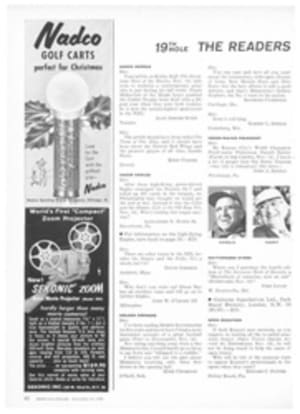
EARS FOR NEW HEROES
In Spanish bull rings this year a handful of outstanding events and personalities illuminated an otherwise mediocre season. The nation's economic recession held down crowds and enthusiasm, and Chapter Two of the monumental mano a mano between Ordó√±ez and Dominguín never came off. Yet there were great performances, such as the afternoon Gregorio S?nchez fought all six bulls in the Madrid ring and cut a record seven ears, and exciting new headline makers, foremost among them a lithe, handsome teen-ager named Paco Camino and the burly, handsome Jaime Ostos.
Camino and Ostos are the standouts in a group of six young men who did the bulk of the season's serious fighting. Most ferocious of the young lions was Camino (69 corridas, 118 ears), who brims with brash confidence. Paco, 17-year-old son of a former banderillero, showed the coolest head in the ring. He gives the impression that he knows more about bulls (and about himself) than most matadors twice his age. As an old ring hand in M?laga described him, Paco is mucho niño, quite a boy.
Camino's most frequent rival was Diego Puerta (71 corridas, 72 ears), a sophomore who would have been dead long ago but for miracles of modern surgery. Puerta has been gored so many times it doesn't seem to bother him any more. He just patches himself up and, like a picador's horse, comes back the next day. Despite his misfortunes, he was Spain's most active matador this season.
Glamour boy of the younger generation is Ostos (58 corridas, 50 ears), who last month gave up his highly rewarding status as the ring's most available bachelor to marry a 17-year-old Córdoba schoolgirl. Jaime is a classic, emotional artist who works frighteningly close to the horns. He used to know his cape and muleta better than his bulls, and in 1957 and 1958, his first two years as matador, he was gored in most of Spain's better rings. His mishaps followed a pattern: disaster would always strike after a fine series of passes, when Jaime had turned his back and was strutting triumphantly away from the bull. Jaime has learned not to turn his back until the job is done, and in the past two years his bulls have stayed fixed when he fixed them.
Juan Garcia (Monde√±o), a tall, delicate and serious sophomore whose hair is turning gray at 26, is another future prospect—if he doesn't become a monk. Devoutly religious, Monde√±o was torn between the two cloths all season, and his fighting showed it. His mediocre record (51 fights, 38 ears) indicates his struggle, for last year he was hailed as the eventual successor to Ordó√±ez.
In the ranks of the novilleros are two very hot performers. One is curly-haired Efrain Girón, younger brother of Cesar, Curro and Rafael, who put Venezuela on the bullfight map. Efrain is hardly a classic torero, but his record is utterly amazing. In 42 appearances this year, he cut 144 ears, or both ears of nearly every bull he faced.
Less spectacular but somehow more pleasing is Santiago Martin (El Viti). Viti is a patient dominator who moves his bulls in sweeping circles, even when he is only luring them from one side of the ring to another. The effect is fascinating and certainly original.
Dramatic and refreshing as they may be, however, these younger fighters have not yet seriously begun to scale the lofty peaks of maestría, fame and fortune commanded by Antonio Ordó√±ez and Luis Miguel Dominguín. Fighting together, as they did last year, or separately, as they did this year, these two men are still the kings of their profession.
Some critics claim their mano a mano fights, which provided the decade's best bullfighting, were called off because Dominguín couldn't stand the competitive pressure. It makes a good story, but it is only partly true. The mano a manos were halted mainly because the old feud between Ordó√±ez and his business agents, the Dominguín family, erupted again last winter after a year's truce. Antonio, angered by the favoritism shown Luis Miguel, broke his contract with the Dominguíns, who sued him and won. The court forced Ordó√±ez to pay them 10% of his earnings until the contract expires.
To decide whether Ordó√±ez or Dominguín was n√∫mero uno this year, Spanish aficionados had to compare them in different rings on different days with different bulls. Most, but not all, think Ordó√±ez is now the best. Certainly his 1960 record is far superior: 82 ears in 56 fights, compared to Dominguín's 41 ears in 42 fights.
But success in bullfighting is not measured in ears alone. Dominguín still fills Spain's plazas de toros faster than Ordó√±ez or anyone else. He still enters the ring to louder, longer applause. For whatever reason, Spain would rather watch Dominguín than Ordó√±ez. The latter, despite his undisputed brilliance, purity and emotion, has never managed to rise above ordinary mortality, whereas Dominguín long ago convinced the public that he is a marvelous and mystical master. Accordingly, he still gets paid more than any bullfighter in the world: 500,000 to 600,000 pesetas ($8,300 to $10,000) a fight to Antonio's 400,000. In Madrid this September, Dominguín fought twice for 800,000 pesetas each time
One afternoon this fall Dominguín fought six bulls all alone—and earned 2 million pesetas, more than any matador has ever collected in Spanish history. He earned every peseta. He gave each of his six bulls a faena tailored to its character, and cut four ears and a tail. On one animal he did something that set bullfighting precedent. As he lined up for the kill, someone yelled, "Kill it with your left hand"; so Miguel, for the first time in history, changed his sword from right to left and went over the horns flawlessly for an estocada fulminante. He was awarded both ears and the tail.
Two weeks later Ordó√±ez tried the same thing. He went in twice for a left-handed kill, but he couldn't even get as far as a half thrust Dominguín had done something Ordó√±ez couldn't, and he'd done it just for the hell of it.
Ordó√±ez may be accepted as n√∫mero uno or, for that matter, even as matador de época. But Dominguín is still the master technician, the bullfighters' bullfighter, the man whom all others watch in awe and the man from whom they learn. Dominguín is the man who can, when he wants to, solve and dominate any bull.
Today, Luis Miguel Dominguín may not be best, but in Spanish hearts he is still n√∫mero uno.
PHOTO
BRASH newcomer among Spanish bull-ring stars is Paco Camino, a full and knowing matador at 17. Camino fought in 69 corridas this year and cut 118 ears.
PHOTO
VINCENT J-R KEHOE
CALM Andalusian Jaime Ostos, a four-year veteran at 25, thrives on close passes. This season he stayed out of hospitals, gave up his gay bachelor life for marriage.
PHOTO
VINCENT J-R KEHOE
IN FIESTA-FILLED MALAGA ARENA, OSTOS PASSES BULL WITH MULETA. HE CUT BOTH EARS, OUTFOUGHT LACKLUSTER DOMINGUIN
PHOTO
VINCENT J-R KEHOE
RHYTHMIC balance of Ostos' muleta leads conde de la Corte bull through a slow and graceful derecha-zo which brings horn inches from the matador's groin.
PHOTO
NOVILLERO EL VITI RESEMBLES MANOLETE
PHOTO
DEVOUT MONDENO MAY BECOME A MONK

